“That the abbey conceals a mystery of a horrible nature I have no doubt.”
—Richard Warner, Netley Abbey: A Gothic Story
Emily Auerbach has persuasively observed that Northanger Abbey was the most autobiographical of Austen’s novels (70).1 As the novel has as its central character a seventeen-year-old heroine, addicted to gothic novels, who leaves her quiet village to seek adventures abroad, then attention should focus on the adventures that the author experienced when she was seventeen years old. In the autumn of 1793, Jane Austen left the family home at Steventon, in the company of her sister, Cassandra, for a visit to the spa town and bathing resort of Southampton.
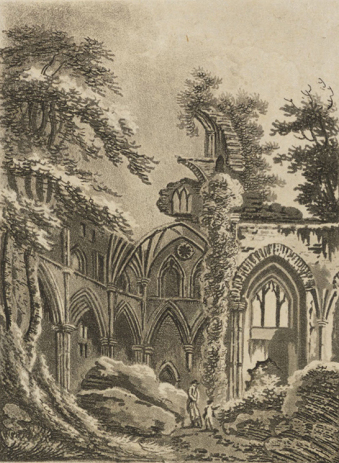
Netley Abbey (1807), engraved by J. Hassell.
Jane Austen was very familiar with the landscape of Southampton, a place where she spent time at three pivotal moments in her life: where she endured a near death experience; where the young flirtatious girl mixed with soldiers, sailors, and the nouvelle riche; and, finally, where she escaped the “unmeaning [l]uxuries of Bath” and turned her thoughts once more to writing.2
As a seven-year-old child, Jane Austen came to Southampton with the woman entrusted with her early education, Mrs. Crawley.3 In 1783 Southampton was at the height of its popularity, having first become an established bathing resort in the 1730s.4 It was also, however, a military port, and although uniformed militia and regular soldiers may have excited the imagination of a young mind, there also lurked danger. An outbreak of typhus during their stay struck down Jane, her sister, Cassandra, and cousin Jane Cooper, leading to their hasty removal from the vicinity. Recent research has suggested that the girls had probably contracted endemic typhus, fortunately a disease from which the young could recover, unlike adult victims (Walker).5 Jane survived the long illness, but her Aunt Cooper, having contracted the disease from her daughter and nieces, did not. The time that the young Austens spent in Southampton was short, so it is unlikely, though not impossible, that the little party made the visit to Netley Abbey, the nearby popular visitor attraction. The abbey was, as Arthur Freeling wrote in his Picturesque Excursions, “The great Lion of the neighbourhood” (Freeling 59–71). In 1783, however, to reach the abbey ruins would have required a lengthy walk and boat ride or a long carriage journey to Mansbridge, the site of the only local bridge over the Itchen.
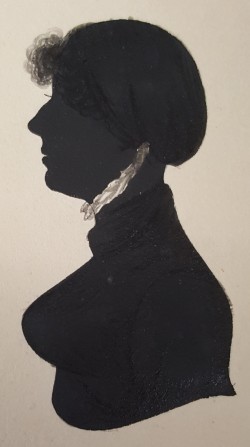
Elizabeth Butler Harrison. The Red Book, Butler Harrison Archive (Southampton Archives D/z 676/1-4).
When Jane was seventeen, described in Love and Freindship as “[o]ne of the best of ages” (Juvenilia 131), she returned to Southampton for an extended visit. Her second stay in the town was much more pleasant and the company rather more prestigious. Jane’s second cousin, Elizabeth Austen, of Tonbridge in Kent, had married a wealthy and politically ambitious young man, John Butler Harrison II. Elizabeth had encountered her future spouse on her own travels around the popular landscapes of Hampshire in 1786. As she wrote to her father, “You see I’m always engaged & happy. I sung forth the praises of Steventon and now I sing forth the praises of Southampton.” Her first excursion on reaching the town was a water party to Netley Abbey which she found to be “an old ruinous place but very romantic and command[ing] a most delightful view.”6
The Butler Harrisons were part of the wider Austen circle. John’s father had inherited Amery House in Alton, and John junior’s half-sister, Elizabeth Goring Butler Harrison, was brought up at Chawton by her paternal aunt, who was married to the vicar.7 Both young siblings had a start in life that could grace any gothic novel, losing their mothers at the time of their births. Their father died before John was born, shortly before the death of John’s mother, Frances Ballard, in 1767. The early tragedy in John’s life led to his being brought up by his maternal family in Southampton, and the property at Amery was sold. Fortunately for John, but frustrating for lovers of gothic novels, his guardians were devoted to him and spared no expense on his upbringing and education. At the time of his marriage to Elizabeth Austen in 1789, he was already part of the urban elite and by the time of Jane’s visit in 1793 had already served as Sheriff of Southampton; the next year he became mayor. The family lived in a substantial property on the edge of the town at St. Mary’s, and their circle of friends included many of the East India Company families who were building houses and villas in the countryside around the town. Families like the Fitzhughs, Lances, and Lewins commissioned picturesque jobbing artists like the Pether family, Abraham, Henry and Sebastian, to provide landscapes for their walls. These included the Pethers’ popular gothic moonlit scenes as a companion to the more usual daytime view. Some families introduced gothic architectural elements to their houses, such as towers and castellation. None went so far as Jane Austen’s future landlord, the Marquis of Lansdowne, who built himself a medieval style castle and festooned the walls with images of French Revolutionaries.

Detail from Old Castle, Lansdown Hill (ca. 1809).
Courtesy of University of Southampton, Hartley Library’s Cope Collection.
John Butler Harrison was one of the group of gentlemen who were determined to improve the town to encourage the visitor economy. His clique was not traditional country gentlemen but men who had earned their wealth through trade, in his case as wine merchant. They encouraged the establishment of the assembly rooms, botanical gardens, and landscaped walks, as well as the rituals for the spa town, and they put in place the infrastructure to enable Southampton to flourish. As the 1781 guide pronounced: “Most gentlemen of this neighbourhood are men of fortune, independence and generosity, who keep the happy medium between avarice and extravagance, meanness and profusion; men who do not debase their character by intimacy with the vulgar and their manners, nor proudly despise their equals, but invariably maintain their dignity by a regular uniformity of conduct” (Southampton 46).
The ruling party successfully petitioned Parliament to be able to establish a Pavement Commission in order to deliver improvements but also to control the look of properties in the town. The Commission’s purview included the paving of all the main streets and the control of the new fashion for bow windows (Stovold 4–9). Property owners had to seek permission to make such alterations. General Tilney of Northanger Abbey, would have approved: “‘if there is one thing more than another my aversion, it is a patched-on bow’” (219). The town was responding to the shifts in the functionality of urban areas. Southampton could not become an industrial city like Manchester or Birmingham, but it could transform into a place for commercialization and leisure.
A growing number of visitors and new inhabitants were drawn to Southampton due to its healthy climate, accessibility, and Royal patrons. To attract visitors, a plethora of printers, stationers, bookbinders, and pamphleteers produced guides and lithographs promoting the town and its attributes. Thomas Baker and James Linden had lucrative side-lines of tourist guidebooks. These began as slim volumes, but each year and each reprint saw the publications swell in size. An early surviving guide produced by Linden in 1768 to be sold in Southampton, London, Salisbury, Bath, and across Hampshire was a mere sixty pages. It claimed to have been written by the late curate of Salisbury. (The clergy led the field in writing histories and guides in this period.8) Linden’s guide intended to provide “rough truths” rather than “polished fictions” (Southampton [1768] iii). Once assured of the probity of the guide, readers could follow the history of the town from Roman times, explore the ancient churches, learn the positive effects of bathing, and discern what to admire about the homes of the local wealthy residents, such as Bellevue, which was said to “exhibit a landscape truly picturesque” (47).
Linden’s guide also recommended a visit to Netley Abbey and quoted from Mr. Willis’s Account of Mitred Abbies. The recommendation related its history; it did not dwell on the description of medieval trefoil windows but, in the spirit of the age, focused on the macabre and the Abbey’s part in the horrible death of Walter Taylor. The survival of Netley Abbey ruins was, to the thrill of visitors, premised on a curse. Local property speculator Walter Taylor had intended to use it as a convenient quarry; however, in a dream the builder was warned that if he removed the stone he would come to a terrible end. Taylor told the dream to Isaac Watts, Sr., a local non-conformist church leader, who advised him to give up the scheme. Greed, however, got the better of Taylor and, as the dream foretold, stone from one of the medieval windows collapsed, hitting him on the head. The ministrations of an incompetent doctor sent him to his grave a few days later. Since that time, it was said, no further stones were removed. The early guidebooks even tracked down relatives of the Watts family to confirm the truth of the story.9 Howitt’s 1864 guide to the Ruined Abbeys & Castles of Great Britain confirmed that the Abbey had since been “uninjured except by time and tourists” (95).
The leader of the picturesque movement, William Gilpin, visited in 1775 and captured the scene in his picture Approach to Netley Abbey. As with many images of the picturesque, the ruins were embellished to improve their beauty. The Baker guidebook of 1775 congratulated the site’s owner on his embellishments. “Mr. Dummer, the present possessor of these venerable ruins, has inclosed them with a wall, and, by a judicious management of the trees, which have spontaneously sprung up among the mouldering walls, has greatly improved the beauty and solemnity of the scene; and by that means, rendered it as well worth visiting as any object of that kind in Great Britain” (Southampton 34).10
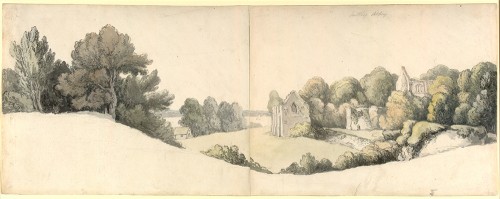
Unfinished watercolor by Thomas Rowlandson (ca. 1794).
Courtesy of the Victoria and Albert Museum.
Netley Abbey owed its reputation to a visit made to the ruins by the torch bearers for the gothic, Horace Walpole and Thomas Gray. Walpole visited in 1755, some nine years before his influential novel The Castle of Otranto was published. The frontispiece of an early edition of that novel had lithographic images that could quite easily have come from Netley. His impression of the ruins is recorded in a letter:
The ruins are vast, and retain fragments of beautiful fretted roofs pendent in the air, with all variety of Gothic patterns of windows wrapped round and round with ivy—many trees are sprouted up against the walls, and only want to be increased with cypresses! A hill rises about the Abbey, encircled with wood. . . . In short, they are not the ruins of Netley but of Paradise. (273)
He was inspired by the ecclesiastical gothic ruins situated in a perfect cloistered location, and Howitt believed that Walpole had even considered restoring Netley Abbey and making it into a house. Gray returned in 1764, as he wrote to the Rev. Nichols:
In the bosom of the woods (concealed from profane eyes) lie hid the ruins of Netley Abbey; there may be richer and greater houses of religion; but the abbot is content with his situation. See here, at the top of that hanging meadow, under the shade of those old trees that bend into half-circle about it, he is walking slowly (good man!) and bidding his beads for the souls of his benefactors, interred in that venerable pile that lies beneath him. (Mason 473)
After waxing lyrical on the Abbey’s gothic credentials, which included the images of past monkish inhabitants, the missive ends: “I should tell you, that the ferryman who rowed me, a lusty young fellow, told me that he would not, for all the world, pass a night at the Abbey (there were such things seen near it), though there was a power of money hid there.” In a short number of years the Abbey had moved from being an historic romantic ruin to being aligned with the tropes of the gothic, a place to experience the thrill of the supernatural and a place that hid buried treasure.
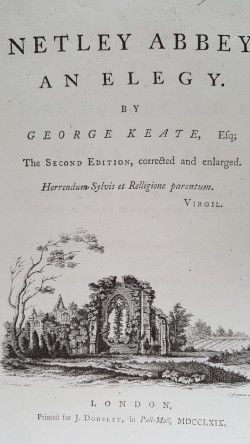
The most successful printer and promoter of Southampton, Thomas Baker, had a London agent, first Thomas Beecroft and later the stationer William Marsh, an arrangement that helped him distribute his publications in the capital. He began his guide of 1775 with a satirical poem, before extoling the virtue of the air of Southampton, “the Montpelier of England” (Southampton 27).11 His description of Netley Abbey refers to Mr. Keate’s “elegant Poem” on the subject: “The beautiful effect of this ruin, and its surrounding scenery, is pleasingly developed in a poem of Mr. Keate’s entitled Netley Abbey, and a writer has chosen it as the theatre of a Gothic Story, in which the machinery of supernatural agency is agreeably managed, and the manners of the feudal ages well adhered to” (Skelton [1815] 78, 27).12
George Keate’s elegy had first appeared in 1764, and in 1765 an anonymous history and poem, “collected from the best authority,” was printed: The Ruins of Netley Abbey: A Poem, in Blank Verse: to which is Prefixed A Short Account of that Monastery, from its First Foundation:
Though claps of thunder rock the tottering pile,
And the swift lightning’s oft repeated flash
Glance through the window with its fading fire—
Or if some meteor in the great expanse,
With streaming flame o’erhang the shaggy top,
Casting a glare amid the foliage wild,
That spreads romantic o’er the abby walls—
Though from some dark recess with ghastly stare,
An airy troop of pale cold shiv’ring ghosts
Should lightly skim along the lonesome void. (Ruins 13)
This poem provided a template for much of the gothic verse about Netley Abbey that followed, with its references to ghosts, romantic yet despoiled ruins, and sinister atmosphere. In its second edition (1769), Keate’s poem was enlarged. It was also included in John Bullar’s A Companion in a Visit to Netley Abbey, a guide that ran to nine editions in the early 1800 so that visitors could read the poem in situ to fully appreciate the atmosphere of the ruins. He used his guides also to promote his Companion in a Tour round Southampton which had a whole chapter and map to Netley Abbey.
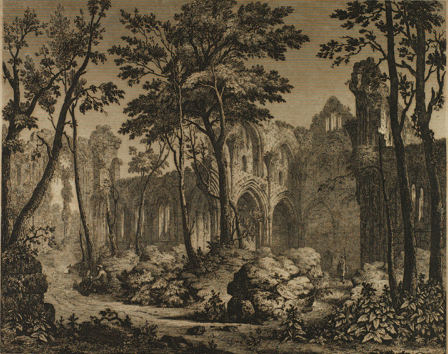
Netley Overgrown (ca. 1790s).
Courtesy of University of Southampton, Hartley Library’s Cope Collection.
Keate was not alone in looking to the Abbey for inspiration. William Sotheby penned his Ode to Netley in 1790,13 and, shortly after Jane’s visit to Southampton, in 1794, William Pearce’s Netley Abbey: An Operatic Farce graced the stage at Covent Garden, with a set design said to be “one of the most picturesque portraits of a Gothic Ruin, that the hand of Science ever produced” (frontispiece). A year later Minerva Press published Netley Abbey: A Gothic Story by Richard Warner.14 At around the age of seventeen, Jane Austen penned an “Ode to Pity,” which could quite easily have been entitled an “Ode to Netley Abbey”:
1.
Ever musing I delight to tread
The Paths of honour and the Myrtle Grove
Whilst the pale Moon her beams doth shed
On disappointed Love.
While Philomel on airy hawthorn Bush
Sings sweet and Melancholy, And the thrush
Converses with the Dove.2.
Gently brawling down the turnpike road,
Sweetly noisy falls the Silent Stream
The Moon emerges from behind a Cloud
And darts upon the Myrtle Grove her beam.
Ah! then what Lovely Scenes appear,
The hut, the Cot, the Grot, and Chapel queer,
And eke the Abbey too a mouldering heap,
Conceal’d by aged pines her head doth rear
And quite invisible doth take a peep. (Juvenilia 97)
Austen has included all the necessary element: a visit by moonlight, atmospheric foliage, the symbolism of sacred groves where one would expect to meet the spirits, references to Greek myths mixed with images of medieval religious ruins. Foreshadowing Northanger Abbey in this early work, she cannot resist poking fun at the excesses found in the profusion of pedestrian poetry being written in the gothic vein by writers of more limited talent than Thomas Gray.
The Southampton guides always had a strong focus on the health-giving properties of the resort. The waters were said to cure ailments including jaundice, scurvy, paralytic disorders, barrenness in females, green and yellow fever, and intestinal blockages.15 Any young lady of high emotions, with aspirations to be a gothic heroine, could take the spa waters to overcome “feebleness experienced by young females, fainting fits, lassitude and other female complaints” (Hayley 3: 66). Jane may have been aware that her favorite poet, William Cowper, visited Netley when sent to Southampton in 1752 to help him overcome depression (Hayley 3: 66). In addition, the 1775 guide said of Netley Abbey that “the whole is overgrown with ivy and interspersed with trees, that it inspires the most pleasing melancholy” (Southampton 36). Baker’s guide for 1795 stated that Southampton had the same “qualities as Tunbridge” (61), and the playwright George Coleman declared that “Tunbridge, Brighthelmstone, Southampton and Margate” were all equally genteel (Temple Patterson 53).
These were the town and surroundings to which the seventeen-year-old Jane Austen and her sister, Cassandra, paid a visit in the late autumn of 1793. The Butler Harrison household also included Elizabeth’s sister, Harriet, and brother, Edgar. Similar in age to Jane, Edgar was then articled to the Southampton Town Clerk, Thomas Ridding, and training as a lawyer. In January 1794 a new arrival, Elizabeth Matilda, eldest of the Butler Harrisons’ daughters, became one of Jane’s goddaughters.
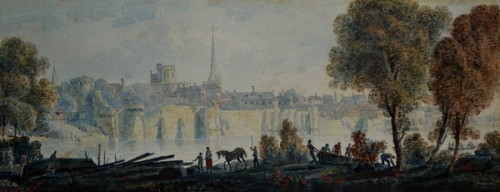
The Old Town Walls (early 19th century), by George Heriot.
Our knowledge of the visit is based on an aside in a letter Austen wrote some fifteen years later, in 1808, when she was also residing in the town (9 December 1808). From this snippet we know that Jane had attended assemblies in the Dolphin Inn, which was sporting new bow windows said to be the largest in England at the time. No letters survive from this 1793 visit, but, if a letter of 1795 is an indication (Tomalin 114), Jane would have danced, perhaps wearing silk stockings, pink silk underwear, and white gloves and, like Silvianora, the heroine of the popular novel by Mrs. Sykes, would have been “delighted at the prospect of exhibiting her pink dancing dress and wreath of white roses at so gay a place as Southampton . . . where she promptly fell in love with a young naval officer” (2: 127).16
Southampton was also a refuge to those fleeing from the real terror in France after the death of Marat in 1793. The refugees had to rely on charity, such as from the doctor John Mackie, whom they thanked for his kindness in “attending their sick beds gratuitously, sending them provisions from his kitchen, and emptying his wardrobe, to supply their immediate wants” (Memoir). There were so many emigres that the Marquis of Buckingham protested to the Foreign Secretary, Lord Grenville, that Southampton was “full of Frenchmen” (Temple Patterson 95). John Butler Harrison and the rest of the town elite were concerned that the unrest and revolution would spread across the channel. The author of The Civil Wars of Southampton wrote in that year about the fear of Jacobin Revolutionary principles spreading to Britain. The Southampton council sent a loyal address to the king, and locals burnt an effigy of Thomas Paine, the author of The Rights of Man, who had influenced both the American War of Independence and the French Revolution (Temple Patterson 41–56, 81–95).
Despite the threat of Revolution and war, we can only speculate that the Austen sisters took the opportunity to partake of the delights that Southampton had to offer, including the chance to visit Netley Abbey or at the very least to read of its delights in the readily available pamphlets and booklets at Baker’s circulating library. The library had been the first established in the county back in 1767, and Baker was keen to promote it through his own guides: “Those who are more fond of instructive and entertaining company should resort to the circulating library, where they will find plenty of food for the mind, hear the news of the day and what is going on in the polite circle” (Southampton [1781] 29).17
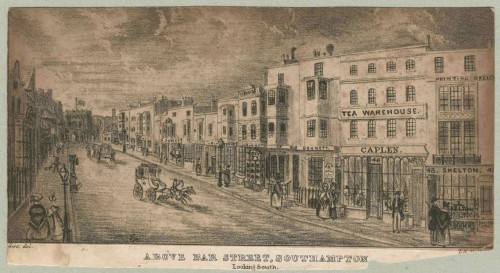
Above Bar Street, Southampton, Looking South.
At the extreme right, Skelton’s printing office and bookstore.
(Click here to see a larger version.)
Baker had produced forty of his own titles, among the 7000 publications on offer to subscribers (Oldfield 17). Some titles were commissioned, such as The Royal Engagement Pocket Atlas, published in 1778 and compiled by Robert Ballard, the guardian of John Butler Harrison II.18 Baker was a pioneer in printing the Pocket Atlas, another string to his printing bow, alongside his guides, his library, and his position as a sometime proprietor of the Hampshire Chronicle. His 1779 advertisement for the Atlas targeted the “politer circles”:
It is presumed the utility of this little performance, in having 365 commodious divisions for the engagements of the year, the uncommon elegance of its execution, on near 40 copper-plates, by that celebrated artist Mr. Hall, with an equal number of pages, replete with useful information for the pocket, in the neatest type the metropolis could furnish, and the whole comprised in a case not exceeding the size of a moderate letter, will merit the patronage and encouragement of a polite and judicious Public. (Jung 4)
Baker re-advertised the publication trumpeting its immediate commercial success. Additions appeared through to the mid-1820s (Jung 4). Baker responded to the publication of popular literary works by commissioning relevant illustrations for his Pocket Atlas. As one of the Ballard circle, Jane Austen must have had access to these fashionable accessories with their insight into popular literature and promotion of consumer culture. As well as enjoying all the leisure activities Southampton provided for visitors, Austen was also exposed to the world of authors, the press, publishing, reviews, and readership, topics that run through Northanger Abbey. The town was also the home of published authors, such as the popular romantic novelists Elizabeth and Jane Purbeck.19 It is also likely that Jane’s hosts had a library of their own, like Mr. Gunthorpe of Bugle Hall, whose books, valued at £600, were lost in a fire in 1791 (Account 3: 7). Certainly Elizabeth Austen’s sister Harriet bequeathed her books to her nieces and nephews.
In and around 1797, shortly after this extended visit to Southampton, followed by her first trip to Bath, the first version of the novel that became Northanger Abbey was written—a novel in which the seventeen-year-old heroine tastes the delights of a spa and takes full advantage of the availability of gothic novels. The manuscript, initially entitled Susan, was not prepared for publication until 1803, when an agent of Henry Austen persuaded the publisher Richard Crosby to buy the novel for £10. Unfortunately, it languished there and was not seen in print until after Austen’s death. In the meantime, in 1806, Jane Austen returned to Southampton as a resident. The household of the widowed Mrs. Austen—her two unmarried daughters and family friend Martha Lloyd—joined forces with that of her son Frank and his new bride. The pooled resources enabled them to rent a substantial property on Castle Square, which was overlooked by their landlord, the Marquis of Lansdowne, and his overblown, pseudo-medieval castle, in which a painting of the death of Marat hung in the drawing room. The painting, according to the Skelton guidebook, was “the very image of atrocity” (New Edition 124). The castle was described by The Times as a “marine villa, in which, from dining hall and private bower to kitchen and scullery, all was pure Gothic” (2 February 1863).
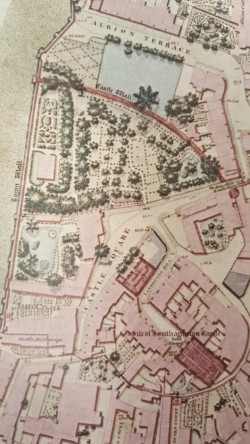
Detail from Ordnance Survey Map (1846). Courtesy of Southampton Archives.
(Click here to see a larger version.)
The Austens could look over their garden wall and view the Summer Assembly Rooms and baths on the West Quay. Their residence, an updated medieval tenement, was encircled by walls that were built in the middle ages. Although some of the towers and gates had been removed to facilitate the carriage traffic of the gentry, much of the medieval gothic town survived, despite the fashion for covering monuments like the Bargate in stucco to make them appear more classical.
Netley Abbey was as popular as ever, attracting artists of the caliber of John Constable, Thomas Rowlandson, and Joseph Mallord William Turner, who came in 1795 to paint its image. By the time of Jane Austen’s third sojourn in the town, the story of Netley Abbey was such that it needed its own volume: John Bullar’s A Companion in a Visit to Netley Abbey. There was even more poetry and prose, although not always of the highest caliber. William Lisle Bowles set his “Fairy Sketch,” with its references to Titania and Queen Mab, at Netley Abbey, and in 1808 Susan Evance, a little remembered author of sentimental poetry, wrote her sonnet “Written at Netley Abbey”:
Why should I fear the spirits of the dead?
What if they wander at the hour of night,
Amid these sacred walls, with silent tread,
And dimly visible to mortal sight!
What if they ride upon the wandering gale,
And with low sighs alarm the listening ear;
Or swell a deep, a sadly-sounding wail.
Like solemn dirge of death! why should I fear?
No! seated on some fragment of rude stone,
While through the Ash-trees waving o’er my head
The wild winds pour their melancholy moan,
My soul, by fond imagination led,
Shall muse on days and years for ever flown,
And hold mysterious converse with the dead! (36)
The gothic style and references used by Keate and others nearly fifty years before were still being employed by poets like Evance: spirits, sacred spaces, the ash tree with its link to Greek, Norse, and Druid mythology. There is an additional layer of sentimentality from Evance on the passing of time and the maudlin possibility of being able to commune directly with the dead.
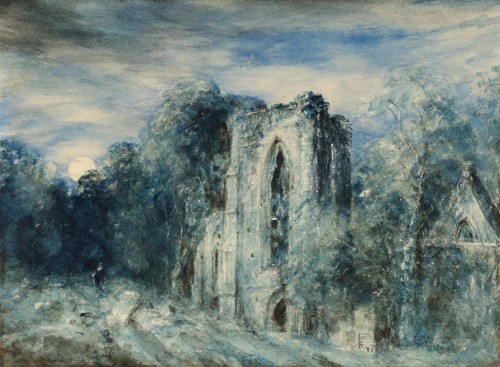
Netley Abbey by Moonlight (1833) by John Constable—painted in his widowhood and probably based on his 1816 honeymoon visit.
Courtesy of the Tate Gallery.
This lugubrious poetry did not deter the numbers of visitors, who went there for picnics and dancing and who carved their names and initials all over the pillars and stones. The Austens themselves went for a picnic, as niece Fanny wrote: “We all except Grandmama took a boat & went to Netley Abby the ruins of which look beautiful. We eat there of some biscuits we had taken, & returned quite delighted.”20 She did, however, also extoll the virtues of Netley: “never was there anything in the known world to be compared to that compound of every thing that is striking, ancient, & Majestic.” She maintained they were all “struck dumb with admiration” (qtd. in Selwyn 53), which may have been why Aunt Jane was quiet on the subject!21
The writers of the guides and other literary works were not above embellishing the story of Netley Abbey and adding new legends and stories of horror, on the flimsiest of evidence or even on no evidence at all. Blind Peter, a monk at the time of the Reformation, was said to walk the ruins guarding its treasure.22 Blind Peter was joined by the ghost of a monk crusader, as well as that of a walled up nun (Barham 293–95). Baker’s guide of 1812, now with illustrations, associated Sir Bevis, legendary founder of Southampton, with Netley Abbey. A “ponderous chest of treasure” was claimed to have been found, and in “the discovery of this treasure, the dream-inspiring influence of Netley was again made evident” (Bullar [1818] 38). Where there was a rumor of treasure, there were of course treasure hunters, such as the unfortunate Mr. Slown. According to the guidebooks, after many years of searching, Slown entered an underground passage that he had discovered only to return a few moments later screaming, “In the name of God, block it up,” before dropping dead (Elder 533). Like the Tilneys’ home at Northanger Abbey the buildings, innocuous in themselves, had been overlaid with gothic fantasy and with the potential thrill of terror from skeletons, hidden tunnels, treasure, and grisly deaths. There was so much information that Baker promoted companion publications (which the firm also produced), such as Englefield’s drawings in his Walk through Southampton and Bullar’s A Companion to a Tour round Southampton.
Towards the end of Southampton’s heyday as a resort, the guides—now illustrated and over two-hundred pages long—looked back to the visit of Walpole and Gray. The Picturesque Excursions of 1839 make a further claim about Southampton’s gothic credentials. It states that a small chapel at Peartree in Itchen Ferry, on the land route to Netley Abbey and where the memorial to John and Elizabeth Butler Harrison can be found, was in fact where Gray wrote his most famous work, “Elegy in a Country Churchyard.” The guide is also dismissive of some of the tales about Netley Abbey: “a treasure seeker has left an unsightly gap in the wall, which formed a part of a handsome niche; it is gratifying to learn that he obtained nothing by his stupidity but his trouble” (Freeling 64)—an aside worthy of Jane Austen herself.
As Jane prepared to leave Southampton for her final home at Chawton, her thoughts turned to the manuscript of Susan still languishing with Crosby. Was it prompted by her return to Southampton, where she had danced, aged seventeen, enjoying the delights of a fashionable spa? Or that she was living under the shadow of a gothic castle with an eccentric owner, whose wife, like a female John Thorpe, careered around the tiny Castle Square in her light phaeton?23 Or by the evolving story of Netley Abbey, from a picturesque romantic ruin to a home for the spectral? Or maybe that the publisher Crosby was heavily advertising its authors and book stock in the Hampshire Chronicle.24 Jane was no longer the young girl who devoured gothic novels but a writer approaching her maturity, who could look back on her young self and desire to review her early work with a more cynical eye. Perhaps, in the same way that she remembered dancing on the verge of her eighteenth birthday, she also remembered what it was like to be seventeen, a heroine in her own story. Whatever prompted her, in 1809 she posted a letter from Baker’s emporium on the Southampton High Street requesting the return of Susan (5 April 1809). The publishers in turn requested the return of their £10. Brother Henry eventually retrieved the manuscript, and it was probably he who suggested the revised name. Henry of course was just as familiar with Netley Abbey from his visits to Southampton as a young militia officer. Perhaps the commercial potential of “the Abbey brand” influenced him to suggest the new title for the manuscript: Northanger Abbey.
NOTES
1“Readers in search of Jane Austen may find more of her in Northanger Abbey than in any other novel she would write” (70).
2“Beware my Laura (she would often say) Beware of the insipid Vanities and idle Dissipations of the Metropolis of England; Beware of the unmeaning Luxuries of Bath and of the Stinking fish of Southampton” (Juvenilia 105).
3Mrs. Crawley was the sister of the Reverend Edward Cooper, who had married the sister of Jane Austen’s mother. Mrs. Crawley’s husband, Ralph, had been Principal of Brasenose College, Oxford, but when he died his widow found herself in straightened circumstances. To supplement her income, she turned to tutoring young girls.
4Brownell credits Alexander Pope with being the first “picturesque tourist of the eighteenth century” after his visit to Netley Abbey in 1734, where he lunched in the woods, sketched the ruins, and admired the view (89). Martin, writing about the visit, called it a “Gothic dream-come-true for Pope” (Thomas 192–93).
5Also called putrid throat or fever at the time, and a concern for Mr. Woodhouse in Emma, and the reason Mrs. Morland was concerned that Catherine wrap up warm about the throat for her trip to Bath (11).
6There are two substantial private family collections of papers and artifacts of the Butler Harrisons. In addition, a third collection was donated to the Southampton Archives by Helena Austen Harrison and can be accessed at D/Z 676/1–4 and D/Z 676/7 1–3.
7Elizabeth Goring Butler Harrison spent her early years in the household of her paternal aunt Jane, who married the Reverend John Hinton of Chawton.
8Dr. John Speed of Southampton, a friend of the Butler Harrisons, was a pioneer historian and produced the town’s first history in 1770.
9Gilpin in his Observations added the detail that in the night Watts was visited by venerable old men in monks’ habits, with frowning faces and threatening hands (350).
10Mr. Dummer’s residence was Cranbury Park, and, when the park was landscaped in the 1770s, part of Netley Abbey was moved and reassembled there to make a folly.
11Montpellier in France with its famous Balaruc baths was promoted by the British doctor Benjamin Pugh in his travel account of 1784.
12Cuthbert Monk was not so impressed by Keate. He quotes him in his 1886 description of Netley Abbey—“(His name forgot, his Guilt divulg’d by Fame), / Some Rude dismantler of this Abbey sleeps”—and adds that Keate has, doubtless, made other people sleep too: “His form [i.e., the pome] went through several editions, and that by far the best edition was the first—it is by far the shortest” (58).
13Sotheby is best remembered as a translator of classic Greek and Roman poetry.
14Richard Warner was a clergyman and antiquarian and worked as curate to William Gilpin at Boldre in Hampshire. He was also an associate of Warren Hastings and William Wordsworth.
15Its reputation was such that in 1785 Benjamin Franklin stayed at Star Inn in Southampton: “I went at noon to bathe in the Martin salt water hot bath and floating on my back fell asleep and slept near an hour,” he wrote (Murrey 10).
16The author Mrs. Sykes was well known to Jane Austen, who certainly read her gothic novel Margiana. Silvianora was the heroine of Stories of Four Nations.
17A typical advert for the library in the Hampshire Chronicle (11 Jan. 1773) said at that time it carried 3,000 volumes, novels, romances, and plays for an annual subscription of 10s.6d or 3s a quarter (Facer 4).
18Robert Ballard was the brother of John Butler Harrison I’s second wife, Frances. Robert and his wife, Melicant, only had one surviving child, a daughter, Melicant, and effectively John Butler Harrison II became their surrogate son. Pocket atlases were very fashionable in the eighteenth century and gave information on social events, maps, and information on the Royal Family. Ballard put up £100 to fund the guide, and Baker agreed to publish it annually. Both men entered into a £5000 bond to seal the agreement.
19In their 1802 novel Neville Castle, their preface praised Camilla, and The Italian.
20Howitt complained about picnickers leaving relics of greasy paper, shrimps, and sardine boxes, which he thought a “strange desecration that one would think every lover of the picturesque would feel instinctively aware of” (95–96).
21The young Jane did not approve of the depredations of the Reformation in her History: “nothing can be said in his [Henry VIII’s] vindication, but that his abolishing Religious Houses and leaving them to the ruinous depredations of time has been of infinite use to the landscape of England in general, which probably was a principal motive for his doing it” (Juvenilia 181).
22The Cistercian monastery was founded by Peter des Roches, bishop of Winchester, and was established in 1239 with monks from Beaulieu Abbey.
23James Edward Austen-Leigh in his memoir of a visit to the Castle Square house described the Marchioness and her “light phaeton drawn by six, and some times by eight little ponies, each pair decreasing in size, and becoming lighter in colour, through all the grades of dark brown, light brown, bay and chestnut,” which he described as a “fairy equipage” (83).
24Jane was revenged on Crosby in her introduction to Northanger Abbey, querying why a bookseller wanted to purchase, and indeed advertise, a publication “he did not think it worthwhile to publish.” She was also aware that literary vogues had moved on in the previous thirteen years and that during that period “places, manners, books and opinions have undergone considerable changes” (1). Southampton’s time as a spa was also drawing to a close and by 1830 was over. Netley Abbey continues to interest gothic tourists to the present day.
